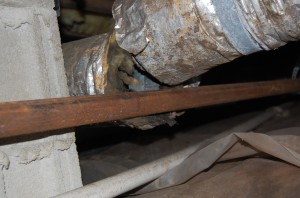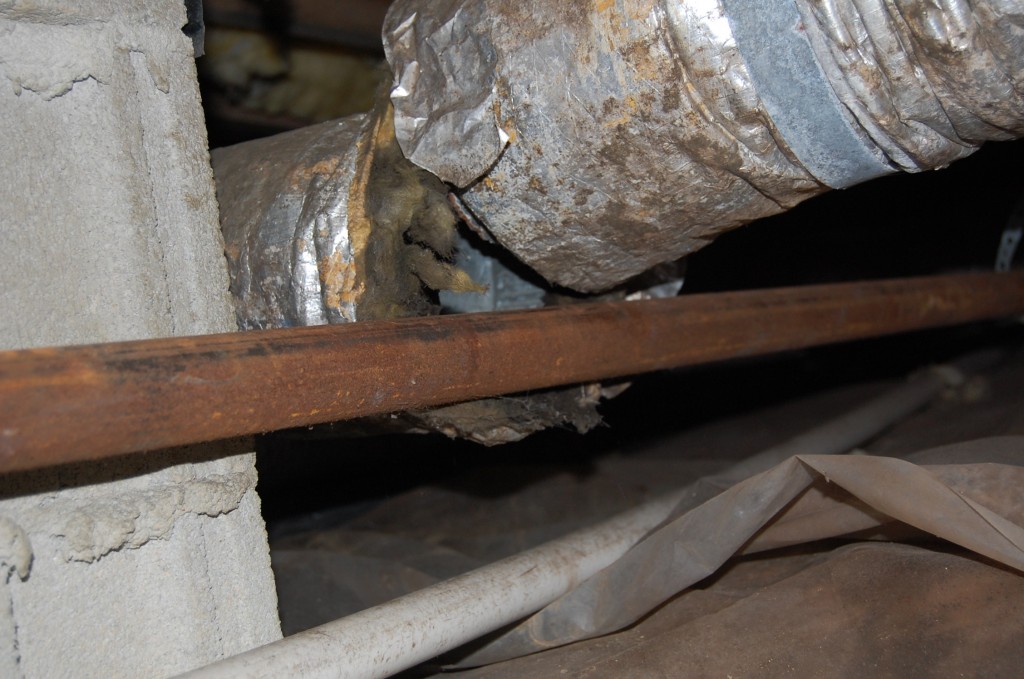
If your dishwasher suddenly sprung a leak and began soaking your kitchen floor you would not have to think twice about repairing it. Not only would you cut off the water you would call a plumber and schedule an emergency visit. Water leaks in your house are messy and can cause a lot of expensive damage but did you know that air leaking from your duct work can be costly and cause damage as well?
It is estimated that 20% of the conditioned air in your HVAC system leaks out through small cracks in the duct work. With numbers like that, nationwide, leaky ductwork could be eating up as much as 5 billion dollars per year! If we wouldn’t tolerate leaky water pipes, we shouldn’t tolerate losing 20% of our expensive conditioned air to heat and cool the neighborhood.
Building codes did not mention the sealing of ductwork until 1983 and to be honest, prior to the energy crisis in the 70’s, no one gave it much thought. Even though the requirement to seal ductwork exists, the enforcement of the code has been spotty or non-existent. A study done in Fort Collins, Colorado found that of the houses evaluated, none of them complied with the duct tightness requirements. Another study in Massachusetts found that 80% of the homes testing failed to comply. After spending as much time under houses and in attics doing Home Energy Audits, I can tell you that these numbers mirror closely what we have discovered.
There are lots of reasons why ducts leak. Some were installed prior to the stricter building codes and simply had no sealant or tape on them at all. Another major cause a leakage is the type of tape used on the ducts. Duct tape is the last thing you want to use to seal ducts. In tests done by the Lawrence Berkeley National Laboratory of duct tape on ducts, they found that 11 of the 12 types failed to maintain a seal within days of being installed. Most tapes are simply not designed to handle the pressure of the air that is passing through duct work especially at the extreme hot and cold temperatures that exist in most people’s attics and crawlspaces. The only type of tape approved for use on ducts is a mastic tape or foil backed tape and that should be used in concert with duct mastic which is the most robust method for sealing duct work. Duct mastic is a painted on substance that hardens over time and can make a complete seal if installed correctly. And even ductwork that was installed correctly can fail over time due to rust and rot and simply being bumped or otherwise compromised by repairmen.
So the next question is “How do I tell if I have a leak?” Visual inspection of the ductwork while the system is running can be helpful. If your pipes are insulated with the yellow or pink fiberglass insulation, you can check the light colored insulation for dark black marks which are the tell tale signs of air movement indicating a leak. Running your hands around the pipe joints may also reveal an air leak but removing the insulation to find the joints may be close to impossible.
The single best method to find leaks is to have a licensed contractor run a Duct Blaster test on your system. A Duct Blaster is a fan with very sensitive manometers built into it. Your supply ducts are sealed with tape and then the pressure in the duct system is lowered by the fan to reveal the amount of leakage in your system. The whole test only takes a few minutes and is harmless to your system and is now a requirement for new houses with the new building codes that are taking effect. A licensed contractor (like a home Energy Auditor) can even tell you how much of the leakage is within the conditioned portion of your house and how much of it is leaking to you unconditioned crawlspace or attic.
The next step is to have the ductwork sealed correctly and then retest your system to insure that the job was done correctly. Is all this work worth it? That depends, is it worth it to lower your utility bill by 20%? Or maybe you like heating your crawlspace.

